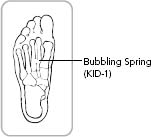AVOID
• Alcohol and coffee, as they tend to irritate the intestinal lining.

• Foods that irritate the intestinal tract, including products containing MSG, preservatives, artificial sweeteners, and chemical additives.

• Some antiviral and most antibiotic drugs, as they destroy the friendly and helpful intestinal bacteria. Some beta-blockers such as atenolol can cause diarrhea, as can heart medications such as digitalis and its derivatives. Many prescription and over-the-counter drugs can also cause diarrhea. Be sure to consult with your physician about possible side effects.

• Stress, anxiety, and emotional turmoil, as they stimulate the sympathetic nervous system, which, in turn, stimulates the bowels.
DIZZINESS
DIZZINESS IS OFTEN DESCRIBED as feeling light-headed, losing your balance, or having the sensation that your head is spinning. There are many causes for dizziness, including central nervous system dysfunction, inner ear infection, sinus problems, Ménière’s disease, anemia, low or high blood pressure, low blood sugar, and fatigue. In some cases, because of a brief lack of blood flow to the brain, dizziness results from a sudden movement of the head or a sudden rise from a sitting position. This is normal, and no treatment is necessary.
In Chinese medicine, dizziness is often seen in patients with anemia, dampness accumulation, or internal wind, which blocks the clear energy from rising to the head. Once the cause is determined, I use acupuncture for symptomatic relief and herbal therapy to nourish the blood, remove dampness, channel wind, and balance inner ear pressure and blood pressure. Dizziness can also be a warning sign of a more severe problem. I once treated a young woman who suffered from intermittent dizziness. She nearly passed out a couple of times in my office. I observed that her pupils weren’t adapting to changing light conditions, and I also saw purple spots on her tongue, a possible sign of a tumor. I sent her to a neurologist for a brain scan. It turned out that she had a tumor in her brain that was causing the dizziness and fainting. I treated her through her surgery and recovery, managing her energy and symptoms successfully. When the pathology came back nonmalignant we all breathed a sigh of relief.
The following are dietary, herbal, and exercise recommendations I have given to my patients. If dizziness is accompanied by vomiting or lingers without relief, work with your physician to rule out serious neurological or vascular disease.
DIET
• Eating nutritious meals helps build abundant energy and blood, and it is crucial to avoid foods that create dampness and stagnation. Eat frequently and in smaller amounts. Eat foods rich in essential nutrients, including whole grains, green leafy vegetables, mint, green tea, onions, ginger, pearl barley, apples, oranges, tangerines, peach kernels, and almonds. Drink plenty of room-temperature water; dizziness can often be caused by dehydration. If you suffer from iron deficiency or blood deficiency, consume more spinach, beets, dandelion greens, and organic red meat. Vegetarians should take vitamin B12 supplements or shots because B12 deficiency often leads to anemia, a cause of dizziness.

• Avoid spicy foods, lettuce, and heavy starchy foods. Moderate your dairy intake. Salt, caffeine, and alcohol should also be avoided. Foods that form mucus, such as dairy, sugar, and wheat, should be avoided, as they block the clear energy from rising to the head.
HOME REMEDIES
• For anemia-induced dizziness eat iron-rich foods, including raisins, prunes, figs, spinach, beets, chard, and calf’s liver at least 3 times a week.

• Make a tea by steeping 3 slices fresh ginger root, 1 tablespoon mint leaves, and 1 teaspoon dried licorice in 1 cup boiling water for 5 to 10 minutes. Strain, and drink 3 cups a day.

• Use 4 drops each of lavender and sandalwood essential oils as an aromatherapy treatment in an infuser, or fill a large bowl with boiling water, add the oils, cover your head and the bowl with a towel, and breathe deeply.
DAILY SUPPLEMENTS
• The B complex vitamins help with proper nervous system functioning and improve blood circulation to the brain. Vitamins C (1,000 milligrams) and E (800 IU) also improve circulation and are good antioxidants.

• Calcium (1,000 milligrams), magnesium (500 milligrams), and zinc (50 milligrams) play key roles in maintaining healthy nerve impulses.

• Omega-3 fatty acids (1,000 milligrams EPA; 800 milligrams DHA), found in fish and flaxseed oils, can improve blood circulation and reduce inflammation.
HERBAL THERAPY
• Herbs can be found in health food or vitamin stores, online, and at the offices of Chinese medicine practitioners. Herbs should be used according to individual needs; consult with a licensed practitioner for a customized formulation. To learn more about the herbs listed here, go to www.askdrmao.com.

• Traditional Chinese herbs including pinellia, atractylodis, and gastrodia are used to provide symptomatic relief for dizziness. Remember, however, to consult your physician, professional herbalist, or doctor of Chinese medicine to address the underlying cause of your dizziness.

• For anemia-induced dizziness, herbs like dong quai, ligusticum, white peony, rehmannia, and licorice are often used.
EXERCISE
During an episode of dizziness, rigorous exercise should be avoided. Gentle walking is a good exercise to stimulate blood flow. As soon as you feel a dizzy spell coming on, step out into fresh air. Sit quietly or take a gentle walk, breathing deeply. Drink plenty of liquids. A regular regimen of moderate cardiovascular and stretching exercises can help maintain good health and proper circulation.
Here is a simple Dao In Qi Gong exercise called The Immortal Awakening from Napping that helps treat dizziness.
Lie on your back with your legs straight and feet apart. Keep your arms resting naturally next to your body, with the palms up. Bring your feet together.
Inhale, and slowly raise your head and shoulders until your shoulder blades clear the floor. At the same time, bring your palms alongside your legs and touch the outside of your thighs. Bring your chin down toward your chest and gaze at your toes. This will connect the body’s energy in a circle from head to toe.
Exhale, reverse the movement, and return to the beginning posture.
Repeat 12 to 20 times twice a day.
ACUPRESSURE
• Locate the acupoint Hundred Meeting (DU-20), at the top of your head, midway between your ears. Apply gentle pressure with your index finger for 5 minutes. This point is used for improving brain and spirit functions.
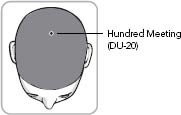
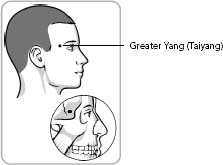

• Find the acupoint Greater Yang (Taiyang), in the indentation in the temples. With either the knuckles of your thumbs or the tips of your index fingers, massage in a circular motion for 5 minutes. This point is used to help clear the head of any stagnation.
AVOID
• Prescription and over-the-counter drugs that can cause dizziness. Be sure to check drug labels. Consult your physician to determine whether drug interactions play a role in your condition. Spironolactone and other antagonists of aldosterone (used for chronic heart failure, it inhibits sodium resorption in the kidneys) can react with alcohol or barbiturates and cause severe dizziness.

• Caffeine, recreational drugs, alcohol, stress, and environmental conditions such as noise and high places, as they can all cause dizziness.

• High cholesterol, low blood sugar levels, and hypertension; they should be treated properly to reduce the risk of complications, which include dizziness.
ECZEMA
ECZEMA (FROM THE GREEKekzema, meaning “to break out”) is a chronic inflammation of the outer skin layer. It is an allergic condition that occurrs in bouts. During its active phase, it produces oozing, crusting blisters, redness, itching, and occasionally pain in the affected areas. As the blisters dry, moisture is lost, resulting in dry, itchy, scaly skin with the appearance of thick leathery patches. The dryness and constant itching—and scratching—may lead to ulcerations of the skin, making it prone to infections. Eczema affects more than 15 million people in the United States, particularly children under the age of five. Eczema is exacerbated by exposure to environmental irritants such as household chemicals, laundry detergents, temperature changes, and dry weather. Food allergies and nutritional deficiencies can contribute to its development. Recent studies have linked stress and anxiety with eczema. Currently dermatologists provide palliative solutions to relieve itching—usually corticosteroids or, in severe conditions, immunosuppressant drugs.
The skin is the largest organ in your body. It is a functional part of your immune system, and it is an interface with the environment with its millions of tiny pores through which substances exit and enter the body. In Chinese medicine, the lungs govern the skin; they are responsible for the proper opening and closing of the pores and for proper nourishment of the skin. When the lung network is impaired, the skin manifests signs of the imbalance. The lung network includes the large intestine, which has the largest number of immune cells in the body. The digestive tract is responsible for removing impure substances from the body, preventing their buildup in the skin. When the bowels are sluggish, constipated, and unable to cleanse the body, toxic substances back up into the skin and show up as lesions representative of damp or toxic heat. In chronic eczema there is often an underlying condition of blood deficiency in which the blood is unable to properly nourish and moisturize the skin. This condition must be addressed.
I have seen many patients with eczema, especially children. One of my three children suffered a terrible case of eczema from one to two years of age. Imagine waking up in the morning to find your child bloody from head to toe from scratching through the night! I treated my child the same way I treat all of my patients. My approach is to first cleanse the body of toxins and residues. Then I work on improving digestive function and harmonizing the immune system to prevent allergic reactions. With strict dietary and nutritional therapies, acupuncture, oral and topical herbal preparations, and stress management, many of my patients have resolved long-standing eczema conditions. And, thank goodness, my child has been fine for seven years now—and in fact has the best skin of all of my kids.
Here are are my recommendations.
DIET
• What you eat eventually ends up in your skin. Many people consume foods without a second thought about what they contain. Chemicals and artificial ingredients can cause allergic reactions and irritate your immune system. Keep a diary of your meals and be attentive to your physical and emotional reactions to food. Soon you will discover whether you have allergic reactions that worsen your eczema. Avoiding problem foods can significantly reduce flare-ups.

• Eat foods that nourish the skin. Incorporate more broccoli, dandelion green, mung beans, lentils, split peas, chickpeas, black beans, lima beans, pinto beans, seaweed, pearl barley, oats, adzuki beans, water chestnuts, winter squash, watermelon, carrots, brewer’s yeast, olives, raspberries, papaya, pineapple, cherries, peaches, apples, pears, raisins, and grapes into your diet. Fish, rich in omega-3 fatty acids, can help nourish the skin. Water is essential for cleansing the body. People who drink at least 80 ounces of water a day tend to have better bowel habits and develop fewer allergic reactions.

• Eliminate processed foods, foods containing artificial additives, bleached white flour, sugars, soft drinks, and spicy, deep-fried, and greasy foods. Stay off dairy products, eggs, shellfish, wheat, corn, tomatoes, eggplant, peanuts, most nuts, caffeine, alcohol, and citrus fruits.
HOME REMEDIES
• Mash 1 small raw potato and apply it as poultice to the affected skin area, changing every 4 hours for 3 days, or until skin improves, to help moisturize the skin and heal the sores.

• Moisturize your skin with calendula oil twice a day.

• Boil 1 cup each of pearl barley and soaked mung beans in 8 cups of water for 1 hour. Drink 3 cups a day for 1 week, or until skin improves.

• Dissolve 1 teaspoon sea salt and 1 teaspoon borax in 1 cup of lukewarm water. Wash the affected area 2 or 3 times a day with the solution to prevent skin ulceration and infections.

• To relieve itching and to help healing, soak the affected areas in natural sulfur springs, if possible, or by adding 1/3 cup each of sulfur powder, Epsom salts, and olive oil to a lukewarm bath at home.
DAILY SUPPLEMENTS
• Supplementing with gamma-linolenic acid (GLA; 800 milligrams) can help modulate inflammatory response. Evening primrose oil and borage oil can deliver substantial amounts of GLA to help regulate the immune inflammatory response.

• Taking probiotics such as acidophilus (3 to 5 billion organisms) is helpful for removing toxic substances and supporting healthy immune response.

• Taking 15 to 30 grams of zinc picolinate a day can help heal skin conditions.

• Supplementing with quercetin (500 milligrams) can reduce eczema flare-ups.

• The antioxidants selenium (200 micrograms) and vitamin C (1,000 milligrams) can help heal the skin.

• Taking MSM (1,000 milligrams), a sulfur-based nutritional supplement, can reduce inflammation and help healing.
HERBAL THERAPY
• Herbs can be found in health food or vitamin stores, online, and at the offices of Chinese medicine practitioners. Herbs should be used according to individual needs; consult with a licensed practitioner for a customized formulation. To learn more about the herbs listed here, go to www.askdrmao.com.

• Burdock, red clover, licorice, chamomile, and calendula are traditionally used for treating eczema.

• Our Exquisite Skin Chinese herbal formula helps to support healthy skin function and reduce itching. It contains siler, caltrop, schizonepetae, astragalus, peony, dong quai, Fo-Ti, rhubarb, and licorice.

• For topical relief from itching, mix 10 drops of Tonic Oil (containing wintergreen, eucalyptus menthol, and other herbs) with fresh aloe vera gel and apply liberally and frequently.
EXERCISE
Stress and anxiety can trigger eczema attacks, so it is important to implement stress reduction exercises in your regular workout routine. Tai chi and qi gong are great for reducing stress and calming the emotions, in addition to their physical benefits. The General Cleansing Qi Gong is designed to help with circulation and promote opening of the pores. It should be done indoors and not too vigorously.
Sit comfortably or lie down on your back. Slow your respiration to deep, abdominal breathing. Say the word “calm” in your mind with every exhalation. In the pathways outlined below you will be visualizing your body parts, relaxing and releasing tension with every exhalation.
Starting at the top of your head, inhale, and then exhale while visualizing your scalp muscles relaxing. Say “calm” in your mind. Repeat this, saying the word as you move down through your face, throat, chest, abdomen, thighs, knees, calves, ankles, and feet. After you’ve relaxed your feet, visualize all the tension in your body leaving through your toes in the form of dark smoke.
Next, start at the temple region of your head. This pathway focuses on the sides and upper extremities. Inhale, then exhale while visualizing your temple muscles relaxing. Say “calm” in your mind. Repeat this, saying the word as you move down through your jaw, sides of the neck, shoulders, upper arms, elbows, forearms, wrists, and hands. Once you’ve completely relaxed your hands, visualize all the tension leaving your body through your fingertips in the form of dark smoke.
The final pathway begins at the back of your head. This pathway relaxes the back of your body. Repeat this breathing-visualization-word routine, as above, as you go from the back of your neck down to your upper back, middle back, lower back, back of thighs, calves, and then heels. Then focus on the acupoint Bubbling Spring at the soles of your feet for 1 minute.
Practice this exercise for at least 15 minutes twice a day.
ACUPRESSURE
• Locate the acupoint Valley of Harmony (LI-4), between your right thumb and index finger. Apply steady pressure with your left thumb until you feel soreness. Hold for 2 minutes. Repeat on the left hand.

• Locate the acupoint Wind Pond (GB-20), in the natural indentation at the base of your skull on either side of your neck. Press and lift up toward the base of your skull with your thumbs and lean your head back. Use the weight of your head against your thumbs for steady pressure on the acupoint. Hold for 5 minutes, breathing deeply and slowly.
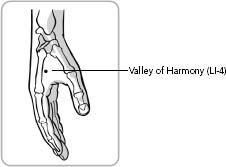
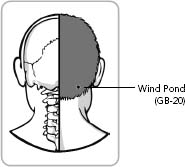
AVOID
• Exposure to temperature changes, cold or hot water, and detergent use.

• Dehydration and constipation, and keep your skin moist.

• Alcohol, smoking, and caffeine; they are irritants that can worsen eczema.

• Stress, anxiety, and emotional turmoil, which can initiate flare-ups.
FLATULENCE
INTESTINAL GAS IS A BY-PRODUCT OF DIGESTION that produces varying symptoms in different people, including bloating, abdominal distention, belching, and the release of rectal gas. The genteel English gave us a more civilized word for gas—flatulence. Though embarrassing and uncomfortable, the production and release of intestinal gas is a normal digestive process. The fermentation and breakdown of foods by intestinal bacteria produces gas. The major causes of excessive flatulence are poor diet and improper digestion. Highly processed foods loaded with chemicals can overwhelm the digestive system, leading to a decline in function and excessive waste products, which can ferment and produce gas. A less common cause of excessive flatulence is aerophagia, or swallowing air with the food we eat.
Chinese medicine recognizes both the dietary causes of flatulence and the emotional element. Flatulence and bloating are signs of a diminished flow of liver energy, which is greatly influenced by mood and feelings. Digestive weakness and a buildup of dampness due to poor dietary habits often accompany liver stagnation. I often ask my patients about their emotional state when treating digestive disorders. My treatments focus on a balanced approach—I use herbal therapy and acupuncture to help support healthy intestinal function and promote smooth flow of energy in the liver-gallbladder network. I also educate my patients about proper eating habits.
DIET
• The food we eat is directly responsible for the production of intestinal gas. The speed at which we eat also has a direct effect. The faster we eat, the more air we’re bound to swallow. Carbohydrates are more gas producing than fats or proteins. Eating smaller, evenly spaced meals more frequently and properly chewing your food are helpful. Foods that reduce flatulence include carrots, black pepper, coriander, chiles, cilantro, limes, lemons, and papaya. Dill, anise, parsley, cumin, caraway, turmeric, and seaweed are also helpful.

• Beans and legumes tend to elicit gas because they are rich in insoluble fiber; in this family focusing on split peas, lima beans, and lentils is your best bet. Beans are less gas producing if you soak them in water overnight before cooking. To further reduce gas production, cook beans with herbs and spices. Fermented soy products such as tofu or soybean are less gas producing. Yogurt and naturally fermented drinks containing lactobacillus acidophilus, a beneficial intestinal bacteria, counteract flatulence.

• Foods containing polysaccharides, including most beans, onions, radishes, sweet potatoes, milk and other dairy products, cashews, broccoli, cabbage, Jerusalem artichokes, oats, and yeast (found in most breads) produce excessive amounts of gas and should be avoided. Stay away from carbonated drinks, as drinking them directly causes gas. Lactose is a major source of gas especially in those who are lactose intolerant. If you do eat dairy products, take the enzyme lactase. Butter and other fatty foods containing butyric acid are responsible for the foul odor in flatulence.
HOME REMEDIES
• For immediate relief from gas, mix 1 teaspoon dried ginger powder with a pinch of asafetida (a resin from the ferula plant, used in pickles) and a pinch of rock salt in 1 cup of warm water, and drink.

• After meals, chew on fresh ginger slices soaked in lime juice to reduce gas production.

• Make a tea by steeping 4 or 5 sprigs of fresh mint in 1 cup of boiling water for 5 minutes. Drink after meals to reduce indigestion and bloating.

• Eat naturally fermented sauerkraut or make your own pickled vegetables by soaking sliced vegetables such as carrots, radishes, or turnips in rice vinegar. Bottle in an airtight jar, and age for at least 1 month in a dark space. Eat a few slices with each meal to help with digestion.
DAILY SUPPLEMENTS
• Probiotics containing 3 to 5 million live bacterial cultures taken daily can help strengthen digestion and reduce flatulence. Use non-dairy-based probiotics if you are lactose intolerant.

• Taking 3 to 4 grams of the digestive enzyme pancreatin with each meal can help with digestion and improve absorption of vital nutrients.

• Take 2 charcoal tablets (500 milligrams) every hour until the symptoms subside.
HERBAL THERAPY
• Herbs can be found in health food or vitamin stores, online, and at the offices of Chinese medicine practitioners. Herbs should be used according to individual needs; consult with a licensed practitioner for a customized formulation. To learn more about the herbs listed here, go to www.askdrmao.com.

• Taking 3 to 5 grams of dandelion root twice daily can aid digestion by supporting liver and gallbladder function.

• Make tea by steeping 1 teaspoon of any of the following herbs and spices in 1 cup of boiling water: dried dill, oregano, cilantro, rosemary, sage, bay leaf, mint, basil, coriander, fennel, anise, cardamom, or turmeric. Drink after each meal to soothe and prevent bloating.

• Traditional Chinese herbs such as hawthorn, massa fermentata, daikon radish seed, tangerine peel, poria, ginger, and licorice are used to support healthy digestion and relieve gas.
EXERCISE
To help move food along the digestive tract and to improve digestion and absorption, the best exercise is walking. The energetic meridians of the digestive organs run along the large muscles of the legs, so walking stimulates energy flow within the channels and promotes digestion. Take an easy 10-minute walk after each meal. While walking, massage your abdomen with your palms in a circular motion around your navel. This helps move food through your digestive tract, avoiding prolonged accumulation.
The following is a movement from the Eight Treasures Qi Gong called Raising the Hands to Adjust the Stomach and Spleen.
Begin in a standing posture with your spine erect, feet drawn close together, and arms at your sides. Tilt your head slightly forward. Begin regular, rhythmic breathing.
Form a cup or plate with your right hand. Facing your palm toward the sky, inhale and make a large circular motion in front of you from the left to right while raising your arm above your head. Be sure to keep your palm facing the sky. As you complete this motion, move your left hand to your back with the palm facing the ground.
As your right hand reaches its highest point above your head, begin to stretch your torso, lifting your body on the balls of your feet. Exhale gently, and simultaneously push your left hand toward the ground. Be sure to push in opposite directions—your right hand pushing to the sky and the left pushing to the ground.
Repeat this movement 3 times, inhaling as your arm goes up and exhaling as you stretch.
Switch sides and repeat the exercise. Do this for 15 minutes, twice daily. The exercise helps stretch the abdominal organs, and stimulates the intestines, spleen, and stomach.
ACUPRESSURE
• Locate the acupoint Valley of Harmony (LI-4), in the web between your thumb and index finger on your right hand. Apply steady pressure with your left thumb until you feel soreness. Hold for 2 minutes. Repeat on the left hand.

• Find the acupoint Upper Great Opening (ST-37) by measuring two hand-widths or eight finger-widths below the outer indentation of your right knee next to your shinbone. Apply steady pressure with your left thumb until you feel soreness. Hold for 2 minutes. Repeat on the left leg.
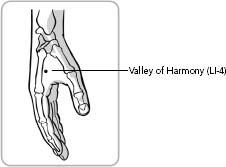
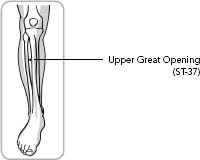
AVOID
• Overeating and eating while anxious, as this takes the digestive energy away from the stomach, making it harder to absorb the nutrients from your food.

• Eating when you are stressed, angry, emotionally upset, or otherwise preoccupied with strong emotional feelings. This stagnates the energy, slows down digestion, and produces gas.
FLOATERS
THE ANNOYING, SPIDERWEB-LIKE IMAGES some people see in their field of vision are not on the surface of your eyes but inside them. Since they tend to float in and out of your vision with the movement of your eyes, they’re called floaters. They’re cellular debris within the vitreous fluid in the eye, a result of degeneration. Though more of a nuisance than anything else, the sudden appearance and rapid increase of floaters may signal rapidly progressing visual decline and should be addressed with your eye specialist.
In Chinese medicine, the liver stores the blood and nutrients that nourish the eye while the kidneys store the vital essence, which is necessary for good vision. Poor eating and lifestyle habits during the younger years depletes these vital substances. When combined with a buildup of metabolic and cellular waste in the form of dampness and phlegm, circulation to the sensory organs is diminished, causing malnourishment of the eyes.
I’ve worked with some very fine ophthalmologists on patients who have annoying floaters. With treatment, many floaters either disappear entirely or are substantially reduced. The treatment includes cleansing and detoxification protocols, herbal and nutritional therapies, acupuncture, and energy exercises like qi gong and tai chi. I instruct my patients in eye exercises and eye massage as well as appropriate lifestyle choices. Here are some of my recommendations—I hope they help you maintain good vision well into your golden years.
DIET
• Proper nutrition is essential for delivering nourishment to the eyes and for preventing a buildup of toxic waste products in the body. I recommend a wholesome, balanced diet rich in complex carbohydrates, organic sources of animal protein, and whole grains. To help nourish the kidneys, the liver, and the vital essence, eat more blood-building foods, including fresh vegetables such as spinach and beets, and dried fruits, such as raisins, figs, and prunes. Turnip tops, leeks, okra, tomatoes, lettuce, Swiss chard, cilantro, yams, carrots, cabbage, green peas, watercress, whole grains, beans (especially soybeans and mung beans), cloves, sesame seeds, and fresh fruits, including apples, peaches, pears, mulberries, blueberries, and blackberries, are all beneficial.

• Foods high in fat content, animal fats, red meat, dairy products, and spicy foods all contribute to the buildup of toxins and waste in the body and should be eliminated. Also avoid coffee and alcohol, which injure the yin essence.
HOME REMEDIES
• Alternate hot and cold eye compresses by applying a hot, moist washcloth to both eyes for 2 minutes, followed by an ice-cold washcloth for 2 minutes. Repeat 3 or 4 times a day.

• Boil 4 ounces of fresh spinach in 4 cups of water for 20 minutes. Drink this broth and eat the spinach daily to provide vital nourishment for the eyes.
DAILY SUPPLEMENTS
• Taking omega-3 fatty acids (3 to 9 grams daily in capsule or liquid form) helps to promote healthy circulation and reduce inflammation.

• Taking daily doses of vitamins A (200 IU), C (1,000 milligrams), and E (800 IU), beta-carotene (1,000 milligrams), and selenium (100 micrograms) can help stop the progression of macular degeneration.

• Daily use of lutein (30 milligrams), another form of beta-carotene, has been shown to help the macula.

• Chlorophyll-rich algae like spirulina, chlorella, and blue-green algae (1 to 2 grams daily) possess nutrients that are beneficial for the eyes.
HERBAL THERAPY
• Herbs can be found in health food or vitamin stores, online, and at the offices of Chinese medicine practitioners. Herbs should be used according to individual needs; consult with a licensed practitioner for a customized formulation. To learn more about the herbs listed here, go to www.askdrmao.com.

• Taking ginkgo biloba on a daily basis can improve circulation to the eyes.

• Make a tea by boiling 1/2 cup chrysanthemum flowers, 1/2 cup mint leaves, and 2 tablespoons cassia seeds in 4 cups of water for 15 minutes. Strain, and drink 3 cups a day to support healthy eyes by strengthening liver function and reducing inflammation.

• Grape seed extract and bilberry extract contain potent antioxidants for eye health.
EXERCISE
An active lifestyle is essential for preventing depletion of the vital essence and the buildup of toxic wastes in the body. I recommend a program that includes cardiovascular exercise every other day and tai chi or qi gong exercises for 30 minutes every day. The exercise called Warming Up the Eyes works directly on the eyes to improve circulation and reduce symptoms, and you can do it every day to help preserve good vision.
Sit at the front edge of a sturdy chair with your back erect, your spine stretched, and your head tilted slightly forward.
Relax and breathe deeply and rhythmically for 3 minutes to promote a feeling of relaxation and calm.
Rub your palms together with some vigor to produce heat. With light pressure, immediately place your palms on your closed eyes. Feel the warming energy from your hands bathing and penetrating your eyes. Hold for 2 breaths.
Repeat 3 times a day.
ACUPRESSURE
• Find the acupoint Gathering Bamboo (B-2), in the depression at the inner corner of the left eyebrow, just above the bridge of the nose. It is traditionally used to restore healthy vision. Apply steady pressure with your left index finger until you feel soreness. Hold for 2 minutes. Repeat on the right side.

• Locate the acupoint Hundred Meeting (DU-20), in the depression at the top of the head, in line with the tips of the ears. It is traditionally used to bring energy to the head area and clear heat from the liver, which can manifest as an eye disorder. Apply steady pressure with your index finger until you feel soreness. Hold for 3 minutes.

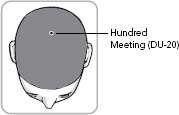
AVOID
• Using the computer and watching TV in the dark, watching a lot of movies, reading in poor light, and wearing sunglasses for long periods of time.

• Stressful situations and emotional turmoil, which rapidly consume the vital essence and aggravate the liver.

• Smoking, exposure to secondhand smoke, and alcohol, which injure the kidney yin essence.
GOUT
THE HUMAN BODY PRODUCES A SUBSTANTIAL AMOUNT of metabolic waste as a result of cellular function. One such waste product is uric acid—a by-product of protein metabolism. Waste products are normally removed from the body through the kidneys and the intestines. Gout is caused either by the overproduction of uric acid or the inability to properly excrete it, leading to a buildup of uric acid in the joints which crystallizes into gout. It usually affects middle-aged men, but postmenopausal women are also prone to gout. Symptoms often occur suddenly and develop within a matter of hours, and include excruciating pain in a single joint—often the big toe—but gout can also show up in the fingers, wrists, elbows, knees, and ankles. The affected joint may become red, swollen, hot, and stiff, perhaps accompanied by fever. In recurring conditions, the person may develop lumps just under the skin in the outer ear, hands, feet, elbows, or knees. One of the most common causes of acute gout is overconsumption of alcohol, red meat, and fats. Excess sugar consumption can also increase the risk of gout.
About fifteen years ago I had a patient with severe gout, complaining of gout attacks about two or three times a year for the previous ten years. I had him keep a diet journal for a week, and then advised him to stop eating red meat, dairy products, and acidic foods, including coffee, wine, tomatoes, citrus fruits, vinegar, and sugar. I used acupuncture and herbal therapy to help relieve his pain and inflammation. I saw him again about a year ago, and I was impressed with how he had stuck to his diet—he never experienced a relapse and looked trim and fit!
In Chinese medicine, joint pain is classified as a painful obstruction syndrome, and it is classified into heat, cold, wind, and damp subcategories based on symptoms. Treatment usually focuses first and foremost on relieving pain and then on resolving the underlying cause. Gout is classified most commonly as heat and dampness accumulation. The red, swollen joint, the sharp pain, and the accompanying heat are part of the symptoms.
Below are some simple recommendations that I suggest to my patients.
DIET
• Eat a diet high in fiber, favoring dark green leafy vegetables, whole grains, and fruits. Also include celery seeds, onions, leeks, shallots, chives, celery, cucumbers, green beans, asparagus, seaweed, capers, and scallions. Strawberries, blackberries, blueberries, raspberries, and black currants contain antioxidants, which can help reduce excess uric acid. Prunes, papayas, pineapple, cherries, and grapes have natural anti-inflammatory and antioxidant properties and should be eaten often.

• Ample water intake is essential for flushing excess uric acid from the system—drink at least 80 ounces of filtered room-temperature water every day.

• High-protein foods should be kept to minimum, and buy organic meat whenever possible. Eliminate foods high in the amino acid purine from your diet (purine metabolism gives rise to uric acid), including anchovies, mackerel, sardines, shellfish, herring, red meat (and gravy), mushrooms, mussels, peanuts, yeast, and sweetbreads and other organ meats. Also eliminate fried foods, processed foods, alcohol, and foods high in saturated fats, sugar, white flour, and caffeine. Avoid spicy foods, citrus fruits, and dairy products, as they can also contribute to gout.
HOME REMEDIES
• Eat lots of cherries and strawberries, as they contain chemicals that neutralize uric acid. Drink freshly squeezed cherry and strawberry juice, or buy unsweetened bottled cherry and strawberry juice, and drink 2 to 3 glasses a day for 1 week during a gout attack.

• Juice 3 stalks of celery with 1 bunch of dandelion green, 3 cucumbers, and 1 bunch of parsley, and combine with 1 cup aloe vera juice. Drink at least 3 glasses of the mixture a day until symptoms subside, or drink 1 glass a day as a preventive measure.

• Soak overnight, then cook 1/3 cup each of mung beans, pearl barley, and red adzuki beans in 6 cups of water for 1 to 2 hours. Eat once a day for 1 month during attacks.
DAILY SUPPLEMENTS
• Taking up to 5,000 milligrams of vitamin C a day can reduce uric acid levels in the blood.

• Taking folic acid (400 milligrams) can slow down the production of uric acid.

• Taking MSM (1,000 milligrams), glucosamine (1,000 milligrams), and chondroitin sulfate (400 milligrams) can reduce inflammation.

• Bromelain (500 milligrams), an enzyme found in pineapples, when taken with meals, can reduce inflammation in the joints and help improve the digestion of proteins.
HERBAL THERAPY
• Herbs can be found in health food or vitamin stores, online, and at the offices of Chinese medicine practitioners. Herbs should be used according to individual needs; consult with a licensed practitioner for a customized formulation. To learn more about the herbs listed here, go to www.askdrmao.com.

• Devil’s claw can help to reduce inflammation and pain.

• Burdock root, colchicum, and celery seed taken as a tea infusion are useful for treating gout.

• Traditional Chinese herbs used for gout include corydalis, stephania root, apricot seeds, forsythia, gardenia, and gentian.
EXERCISE
Don’t engage in strenuous physical activity during an acute attack of gout. Rest can help reduce stress and speed up healing. After the attack subsides, regular physical activity is important for maintaining good health and ideal weight, as obesity can increase the risk of developing gout. Focus more on stretching and improving flexibility and less on strength-and muscle-building exercises. Walking, swimming, and cycling are good choices. Tai chi and Dao In Qi Gong exercises practiced regularly normalize metabolism and support muscular and skeletal health. Below I describe a quick Dao In Qi Gong exercise called Watching Twin Flying Horses Scratching Each Other, which helps alleviate gout symptoms. Practice it regularly and you’ll see the benefits.
Sit on the floor with both legs straight out in front of you. Place your arms straight behind you, with your palms on the floor. Lean your upper body back at a 45-degree angle, supported by your arms.
With the bottom of your right foot, rub the top of your left foot up and down from the ankle to the toes 36 times.
Then with the bottom of your left foot, rub the top of your right foot up and down from the ankle to the toes 36 times.
Next, with the heel of your right foot, rub the sole of your left foot from the heel to the base of the toes 36 times.
Finally, with the heel of your left foot, rub the sole of your right foot from the heel to the base of the toes 36 times.
This exercise can be done anytime, but it’s particularly beneficial just before going to bed.
ACUPRESSURE
• Find the acupoint Kunlun Mountains (UB-60), between the outer right anklebone and the Achilles tendon in your heel. With your right thumb and index finger, pinch the point for 3 to 5 minutes. Repeat on the left foot. As you engage this acupoint you are also stimulating the Forceful Torrent (KID-3) acupoint, which is located between the inner anklebone and the Achilles tendon, just opposite Kunlun Mountains. These are kidney and bladder points, and stimulating these areas can help support the functioning of the corresponding organs, thus alleviating gout.

• You can also engage trigger points as a self-acupressure treatment. Find the trigger point by pressing around to discover the most sensitive point. Apply a small amount of vodka to the tender spot. With your thumb or middle finger rub the point, at first gently and then increasing the pressure to as much as you can tolerate, for 5 to 10 minutes.

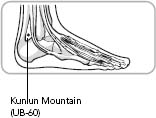
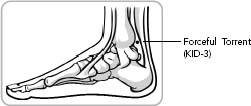
• Soak your feet in a warm Epsom salt bath every night for 15 to 20 minutes before going to bed to speed circulation of uric acid out of the feet.
AVOID
• Smoking and overindulging in alcohol, as these substances are irritants, and alcohol can cause acute gout flare-ups.

• Certain medications that can cause gout, including aspirin, immunosuppressants, diuretics, drugs used to treat Parkinson’s disease, and some antibiotics. Consult your physician if you’re taking any of these medications and suffering from gout.

• High doses of niacin (vitamin B3), nicotinic acid, and vitamin A, as they can cause an attack of gout. Do not use larger-than-normal doses of these supplements unless advised to do so by your heath care provider.
GUM DISEASE
OVER 50 PERCENT OF AMERICANS over thirteen years old suffer from some form of gum disease. Gum disease can lead to tooth decay and, if not treated, to the complete loss of teeth. In its mild stage, gum disease is called gingivitis, which simply denotes inflammation of the gums. More severe gum disease, characterized by plaque buildup, is called periodontal disease. About 45 percent of people over sixty suffer from some form of periodontal disease. Heart attack and pancreatic cancer have been linked to periodontal disease—the bacteria that infect the gums can also irritate the walls of the arteries and induce clot formation, leading to heart disease. Infection and inflammation can also cause an increase in stomach acid production, and the bacteria can produce carcinogens such as nitrosamine in the mouth, which can increase the risk of developing pancreatic cancer.
Brushing your teeth and flossing protect against periodontal disease to some degree, but regular visits to your dentist are essential for maintaining gum health. Tooth and gum pain; red, shiny, bleeding gums; receding gums; visible plaque between the teeth; and loose teeth are all symptoms of gum disease. Severe gum disease often requires periodontal surgery, causing much grief and suffering. I have worked with dentists and periodontists on a program of gum health for patients with gum disease. The program includes a special diet to keep the oral environment alkaline, and thus unfriendly to bacteria, and simple oral rinses several times a day, coupled with massaging the gums with Tonic Oil.
The gums are an extension of the digestive system, and in Chinese medicine they reflect the condition of the stomach-spleen-pancreas network. Gum disease is caused by excess heat in the stomach due to improper diet or lifestyle or emotional stress. My treatments focus on nourishing the digestive system, cooling the heat—which translates into inflammation or infection—and educating my patients on proper diet, lifestyle, and stress management.
DIET
• To prevent gum disease, eat a varied diet consisting of fresh fruits, vegetables, beans and legumes, and whole grains. Drink plenty of water. Eat smaller meals, and chew your food well to allow proper enzyme secretion and healthy digestive function. Avoid overeating by eating to just 80 percent of your capacity.

• Avoid sugars, refined processed foods, and highly acidic foods, including coffee, soda, and alcohol. Reduce your consumption of spicy, greasy, and deep-fried foods.
HOME REMEDIES
• Nothing replaces brushing your teeth on a regular basis for preventing gum disease. Always brush before and after meals and before and after sleep. Brushing with baking soda after brushing with your toothpaste will alkalinize the gums, temporarily discouraging bacteria from developing.

• Massage Tonic Oil (available at www.askdrmao.com), consisting of essential oils of wintergreen, eucalyptus, and mint in a sesame oil base, into your gums twice a day to stimulate blood flow to the gums. The essential oils are natural antibacterial agents and are a good antidote for bad breath.

• Make your own mouthwash or rinse by mixing 1 tablespoon of food-grade hydrogen peroxide and 1 tablespoon of baking soda in a glass of warm water. Rinse first thing in the morning and before bedtime.
DAILY SUPPLEMENTS
• Using a folic acid mouthwash and folic acid (400 micrograms) as a supplement can prevent and heal gum inflammation.

• Vitamin C (1,000 milligrams), bioflavonoids (500 milligrams), coenzyme Q10 (50 milligrams), calcium (1,000 milligrams), and zinc (50 milligrams) supplements are helpful in fighting gum disease.

• Fish oil and flaxseed oil contain a rich supply of anti-inflammatory omega-3 essential fatty acids (1,000 milligrams EPA; 800 milligrams DHA), which are good for preventing and treating gum disease.
HERBAL THERAPY
• Herbs can be found in health food or vitamin stores, online, and at the offices of Chinese medicine practitioners. Herbs should be used according to individual needs; consult with a licensed practitioner for a customized formulation. To learn more about the herbs listed here, go to www.askdrmao.com.

• Bloodroot, caraway, echinacea, sage oil, peppermint, menthol, and myrrh in their essential oil forms are good for treating gum disease.

• Traditional Chinese herbs used for treating gum inflammation include coptidis, skullcap, anemarrhena, gypsum, peony, and rehmannia.

• Herbs used as a preventive include lotus, mulberry, cassia seed, chrysanthemum, hawthorn, and mint.
EXERCISE
Physical activity helps maintain good digestion and can reduce stress, anxiety, and excessive emotions, all of which can cause heat to build up in the stomach. A daily fitness program consisting of 30-minute daily walks and a regular practice of qi gong or tai chi will promote a healthy digestive system, which benefits the gums. The following is part of the Eight Treasures Qi Gong practice known as Pushing Down the Fierce Tiger. It works to strengthen the teeth, improve circulation to the gums, and improve oral health.
In a quiet, comfortable environment, preferably outdoors, stand with your feet shoulder-width apart, knees slightly bent, spine erect, tailbone tucked in, and head tilted slightly forward. Place your arms palms down on your lower abdomen just below the navel, one hand on top of the other.
Begin with rhythmic, slow, and relaxed breathing. Inhale deeply but softly, and imagine the breath extending all the way down to the lower abdomen, about two finger-widths below the navel. Exhale gently and softly. Stay in this position for 7 breath cycles, relaxing and calming your mind.
Now begin the exercise—you will be moving the energy from the inner part of your legs up into your lower abdomen. Then, in a brisk but gentle move, you’ll push it back down to the ground with your teeth gently clenched.
On an inhale, bend forward, and extend your arms to the inner part of your lower legs. Begin massaging the inner part of your leg in a tight circular motion, starting at your lower leg and moving up to your knee, inner thigh, groin, and into the lower abdomen.
Exhale, and with your palms facing down push the energy briskly down toward the ground, bending your knees to accommodate the motion. Remember to keep your spine erect and your upper body straight.
Repeat the exercise 3 times a day. Return to the starting posture and stand for 1 minute in quiet meditation after completing the exercise.
ACUPRESSURE
• Find the acupoint Nectar Receptor (REN-24), in the depression at the center of the lower chin about a finger-width below the lower lip. Apply steady pressure with your index finger until you feel soreness. Hold for 1 minute.

• Find the acupoint Three Yin Crossing (SP-6), four finger-widths above the right inner anklebone, in the depression near the bone. Apply steady pressure with your thumb until you feel soreness. Hold for 3 minutes. Repeat on the left leg.

• Engaging the combination of these points can help reduce inflammation of the gums.
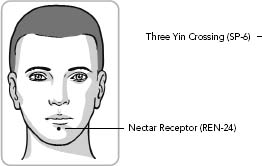
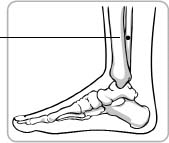
AVOID
• Smoking and using chewing tobacco, as they can cause gum disease and oral cancer.

• Sugar, which is the worst culprit for tooth decay and gum disease.

• Seizure medications such as phenytoin, which can cause gum disease and tooth decay. Consult your doctor.

• Stress and emotional turmoil, as they can lower immune function, increase inflammation in the body, and create heat. Try to remain calm and practice stress-reduction methods.
HAIR LOSS
THE AVERAGE PERSON HAS MORE THAN 100,000 hair follicles in the head alone, each capable of producing at least twenty hair strands in a lifetime. Hair growth is affected by the hormonal system, in particular the androgenic (male) hormones, which include testosterone and a derivative of testosterone called DHT. Normally a person loses about 100 hairs each day, which are replaced within days. As we age, our hormone levels fluctuate and begin to decline, which reduces the stimulus to the hair follicles and results in hair loss. Hair loss affects both men and women, though it is more pronounced in men. There are many types of hair loss, or alopecia, in addition to those related to age. A type of hair loss known as alopecia areata occurs in patches, primarily affecting the head. Less common are drug-induced (chemotherapy) hair loss and genetic hair loss. Entire industries exist to help ease the emotional and social impact of baldness; purported solutions range from invasive surgical procedures to miracle drugs and ointments.
In Chinese medicine, hair loss is attributed primarily to the decline of the vital kidney essence as a result of overindulgence during youth. Stress, physical and emotional strain, an unhealthy lifestyle (including excessive sexual activity), and alcohol deplete the vital essence. This is often complicated by blood deficiency in the patient, as in cases of patchy hair loss resulting from pregnancy and giving birth, the mother being severely depleted of her vital essence and blood. I’ve had the gratifying experience of helping many patients recover from hair loss, whether the result of chemotherapy, radiation treatment, stress, or menopause. One of my patients who had extensive radiation to her scalp for brain cancer was told by her radiologist that her hair follicles had been permanently damaged. I’m happy to report that she now has a full head of hair. She even wrote about her experience, and she included a photograph that we published in our Tao of Wellness newsletter.
My approach to hair loss is to help replenish the vital essence by administering herbal remedies and advising my patients on proper lifestyle, diet, and exercise. I also incorporate topical remedies and acupuncture to stimulate circulation and the hair follicles. In general, alopecia responds well to topical remedies and acupuncture.
DIET
• Diet must be focused on replenishing kidney essence and nourishing blood. In addition to organic vegetables, grains, and fruits, you should favor walnuts, sesame seeds, sunflower seeds, pumpkin seeds, beets, beet tops, mushrooms, mulberries, blueberries, raspberries, blackberries, cranberries, apples, pears, peaches, black beans, mung beans, and other beans and legumes. Add organic lamb, chicken, and deep-sea fish to your diet for quality protein.

• Eliminate processed foods, artificial additives, bleached flour, sugars, soft drinks, and spicy, deep-fried, and fatty foods.
HOME REMEDIES
• Massage the affected area on your scalp with fresh ginger juice. Wait 10 minutes, then tap the affected area with the bristles of a stiff toothbrush for 3 minutes, stimulating the scalp. Do this twice daily for 1 month. It promotes circulation and decreases oily deposits that block follicles.

• Apply aloe vera juice directly from the stem of the plant to the affected area twice daily for 1 month.

• Practice handstands, shoulderstands, or headstands for 1 to 2 minutes every day. This will increase blood flow to your scalp.
DAILY SUPPLEMENTS
• Methysulfonylmethane (MSM; 1,000 milligrams) is a building block of strong hair.

• Biotin (500 micrograms) and vitamin B complex are essential nutrients for hair growth. Vitamin E (800 IU) increases oxygen uptake and zinc may stimulate hair growth by enhancing hormonal function.

• Vitamin C (1,000 milligrams) together with bioflavonoids improves circulation to the scalp, while silica aids hair growth and strengthens hair.

• The amino acids L-methionine (500 milligrams), L-cysteine (500 milligrams), and glutathione (600 milligrams) improve the overall quality, texture, and growth of hair.
HERBAL THERAPY
• Herbs can be found in health food or vitamin stores, online, and at the offices of Chinese medicine practitioners. Herbs should be used according to individual needs; consult with a licensed practitioner for a customized formulation. To learn more about the herbs listed here, go to www.askdrmao.com.

• Evening primrose (300 milligrams GLA), flaxseed, and fish oils (1,000 milligrams omega-3) are good for preventing damage to the hair and hair follicles. They are usually taken in capsule form.

• Ginkgo biloba (120 milligrams daily) improves circulation to the scalp, green tea (300 milligrams polyphenol content) provides antioxidant benefits, and saw palmetto (320 milligrams) blocks DHT and prevents hair loss.

• Traditional Chinese herbs used to prevent hair loss include Chinese arborvitae (flat fir leaves), eclipa, Chinese foxglove, black cohosh, vitex, ginger, and sesame.
EXERCISE
Regular physical exercise is important for maintaining proper circulation to the scalp. Excessively strenuous exercise is not recommended, as it will deplete vital energy. Stress-reduction exercises and meditation can help regulate your energy and strengthen your essence. I recommend a Dao In Qi Gong exercise called Gentle Rainfall Experience, which promotes blood circulation to the scalp and hair follicle, to all my hair-loss patients. Do the exercise twice a day for best results.
Sit comfortably at the edge of a stiff chair, or cross-legged on a soft pillow.
With the tips of every finger (including the thumbs) gently tap your head all over, stimulating the scalp for about 1 minute. Use light force at the beginning and gently increase to moderate strength.
Massage the scalp with both hands, moving the scalp gently and then more vigorously for 2 to 3 minutes.
Straighten the fingers of your right hand, and with the palm side of the fingers gently tap all over the scalp 36 times. Then do the same with your left hand another 36 times.
ACUPRESSURE
• Locate the acupoint Forceful Torrent (KID-3), between your right anklebone and right Achilles tendon. Pinch the point with your right thumb and index finger and hold for 3 to 5 minutes. Repeat on the left foot.

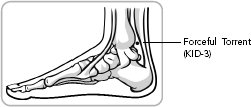
• Use a stiff toothbrush or the tips of your fingers to tap the balding area with moderate strength for 5 minutes twice a day to help invigorate blood circulation.
AVOID
• Chemicals, food additives, and pesticides, as they may interfere with healthy hormonal functions, potentially injuring the hair follicles.

• Stress and exhaustion, which damage the vital essence and deplete the kidney energy.

• Certain gout medications, antiarthritis medications, and antidepressants, as they can cause hair loss. Check with your physician for alternatives.
HEADACHE
MOST PEOPLE GET OCCASIONAL HEADACHES as a result of catching a cold, staying up too late, or drinking too much, enduring the consequences the next morning. One in six Americans experiences chronic headaches, which can be caused by sinus problems, muscle tension, eyestrain, jaw clenching, a virus, or allergies. Headaches can be experienced at the front of the head, the temples, the back of the head near the neck, and the top of the head. Factors that worsen headaches include poor eating habits, stress, and lack of sleep. Headaches can occur during the day or in the evening, while you are active or at rest. In complicated cases like migraines or neurological headaches, the headache may be accompanied by sensitivity to light and sound, nausea, and vomiting. (Migraine headaches are addressed on page 408.)
According to Chinese medicine, pain is the body’s signal that there is a blockage of energy and blood. Causes of the stagnation include developing a cold, depression, or trauma to the energy meridian as a result of physical injury. By identifying the underlying cause of the headache, I deliver targeted therapies to my patients, including acupuncture for pain relief, herbal medicine for inflammation and muscle spasms, diet therapy to eliminate allergies, and meditation to reduce stress and tension.
Below I’ve summarized my favorite home remedies for headaches. Note that headaches may be caused by severe medical conditions like glaucoma and brain hemorrhages. If you experience severe, debilitating headaches that don’t respond to over-the-counter medication, or if you wake up in the middle of the night with excruciating head pain, visit your physician or the emergency room immediately.
DIET
• Energy and blood flow rely heavily on what we consume on a regular basis—the foods we eat eventually end up in our blood and meridians in the form of energy. Proper eating habits can help maintain a good flow of energy and blood to the head, preventing headaches. Eat wholesome foods free of preservatives, additives, and other artificial ingredients. Artificial colors and preservatives such as sulfites in wines and dried fruits can cause headaches. Add a good amount of fiber-rich foods, including whole grains, green leafy vegetables, parsley, chrysanthemum flowers, mint, green tea, onions, ginger, pearl barley, carrots, prunes, buckwheat, peach kernels (eaten like raw nuts), and almonds. Eat regularly, more frequently, and in smaller quantities. Do not eat on the run or while under stress. Do not eat late at night or lie down immediately after eating.

• Avoid greasy and fried foods. When oils are heated they produce chemicals that can cause headaches. Spicy, stimulating foods and heavy starchy foods should be avoided as well. Drinking coffee or other caffeinated beverages can raise blood pressure and cause headaches, although sometimes caffeine can temporarily relieve headaches. Giving up coffee abruptly can cause withdrawal headaches at first. Drinking alcohol can also cause headaches.
HOME REMEDIES
• Make a rice porridge by simmering 1 cup of white rice with 2 chopped green onions, 1 garlic clove, and 5 slices of ginger in 6 cups of water for 20 minutes, keeping the pot covered. The spices will make you sweat and boost your immune system, which helps to fight virus and bacteria. This porridge is also good for treating high blood pressure, PMS, and tension headaches.

• Make a tea by boiling 5 prunes, 1 tablespoon green tea, and 2 tablespoons chopped fresh mint in 3 1/2 cups of water for 15 minutes. Strain, and drink 3 cups a day until the headache subsides. You may also eat a handful of prunes 3 times a day until the headache subsides.

• Make fresh carrot juice and drink a glass every 4 hours until the headache subsides. Also put carrot juice in a small squirt bottle, and squirt a little carrot juice into the left, right, or both nostrils, depending on where the headache is located.

• Put 5 drops of lavender essential oil in 1 cup of warm water. Soak a small towel in the water, and then wring it dry. Place it on your forehead as a compress to alleviate a headache.
DAILY SUPPLEMENTS
• Magnesium (500 milligrams) and calcium (1,000 milligrams) can help control muscle spasms and can help relieve tension headaches.

• The amino acid 5-HTP (100 milligrams), fish oil (1,000 milligrams EPA; 800 milligrams DHA), vitamin B2 (riboflavin; 400 milligrams), chromium (200 micrograms), folic acid (800 micrograms), and vitamin C (1,000 milligrams) can be helpful for temporary relief of headaches.

• Niacin (vitamin B3; 500 milligrams) is useful for treating acute headache attack. Take 3 times a day when you have a headache.
HERBAL THERAPY
• Herbs can be found in health food or vitamin stores, online, and at the offices of Chinese medicine practitioners. Herbs should be used according to individual needs; consult with a licensed practitioner for a customized formulation. To learn more about the herbs listed here, go to www.askdrmao.com.

• Make a tea by boiling 2 tablespoons each of chrysanthemum flowers, cassia seeds, and mint leaves in 4 cups of water for 15 minutes. Strain, and drink 3 cups a day until the headache subsides. These herbs help clear the sinuses and reduce the pressure in the head.

• Feverfew has been used since ancient times for treating headaches, and some studies show that it may help reduce the frequency and severity of headaches.

• Traditional Chinese herbs used for headaches include mint, ligustici, angelica, notopterygii, siler, schizonepetae, green tea, and licorice.
EXERCISE
I recommend avoiding vigorous exercise during headache episodes, as exercise may worsen the condition. Taking a walk in fresh air will help stimulate blood flow and increase oxygenation to the head. Gentle walking can nip the headache in the bud before it starts—as soon as you feel a headache coming on, step out into the fresh air and go for a 10-minute walk, breathing deeply and vigorously. A regular regimen of moderate cardiovascular and stretching exercises can help maintain good health and proper circulation. Daily meditation practice and tai chi exercises can also help. Here is a simple visualization meditation called White Light Meditation that I teach my patients.
Sit or lie down comfortably. Clear your mind, relax your body, and breathe deeply and slowly.
Inhale, and visualize a white light or clear mountain spring water entering your body at the top of your head and flowing down to your abdomen.
Exhale, and visualize the white light or water continuing its downward course from your abdomen to the bottom of your feet, where it drains out.
Repeat the breathing cycle and visualization for 10 minutes. Do this meditation often as necessary—it often brings on a quick reduction in symptoms.
ACUPRESSURE
• Locate the acupoint Wind Pond (GB-20), in the natural indentation at the base of your skull on either side of your neck. Press and lift up toward the base of your skull with your thumbs and lean your head back. Use the weight of your head against your thumbs for steady pressure on the acupoint. Hold for 5 minutes, breathing deeply and slowly.

• Find the acupoint Greater Yang (Taiyang), in the indentation of the temples. Stimulate the point with the knuckles of your thumbs or the tips of your index fingers. Massage in a circular motion for 5 minutes.

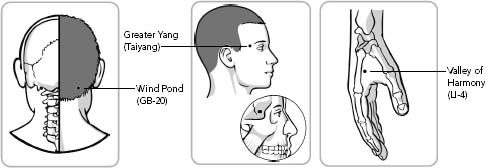
• Find the acupoint Valley of Harmony (LI-4), in the web between the thumb and index finger on your right hand. Apply steady pressure with your left thumb until you feel soreness. Hold for 2 minutes. Repeat on the left hand.

• You may wish to check out whether there are any physical imbalances in your spine, neck, or jaw, as these imbalances can exacerbate headaches. Proper structural adjustments may be helpful—consult a chiropractor or an osteopath.
AVOID
• Some medications that cause headaches, including birth control pills, antihistamines, vasodilators (such as nitroglycerin), isosorbide dinitrate, anti-arrythmic agents (such as quinidine), digoxin, and ergotamine. Hormone therapy can also cause headaches. Consult your physician for alternatives.

• Caffeine, recreational drugs, and alcohol. Lack of sleep is another major cause of common headaches. The common cold and neck injuries also may cause headaches.

• High blood pressure and blood sugar fluctuations; they should be regulated and controlled, as both of these conditions can cause headaches.
HEARING LOSS
AN UNFORTUNATE FACT: THE AVERAGE PERSON starts losing hearing in his or her twenties. The loss is so gradual that most people don’t notice until it affects their lives. Even when they need to use the highest volume on the television, some people don’t recognize or admit that they have a hearing problem. The gradual deterioration of hearing is primarily a result of the environmental, lifestyle, and dietary choices we make during our youth. The popularity of digital audio players is certainly adding to the problem. Continued exposure to loud environments, inadequate sleep and rest, overindulgence, and being overworked place an enormous amount of strain on the body. Combined with a poor diet, including increasing amounts of chemical and artificial ingredients in our food, our bodies begin to fail as a result of toxic buildup. For example, there is a link between high blood cholesterol and loss of hearing. Genetic, physical, and other disease factors may also be involved. Some childhood illnesses, such as measles, mumps, and chronic adenoid inflammations (inflammation of the tonsils), can lead directly to hearing loss.
Chinese medicine recognizes a link between hearing loss and the underlying essence of the person. Prolonged overindulgence and being overworked during youth deplete the body’s vital essence, causing deficiencies—especially of the kidney-bladder network. Depleted kidney energy can lead to a premature decline in hearing. Strong emotions such as anger and frustration can aggravate the liver energy, which rises to the head and ears, producing hearing impairment and tinnitus (ringing in the ears). Ménière’s disease, an inner ear condition, often corresponds to a rise in liver energy. Acute loss of hearing is often associated with external pathogens such as the viruses that cause colds, flu, ear infections, and shingles.
I’ve worked with a number of ear, nose, and throat specialists on hearing-related problems in patients ranging from three to ninety-three years old. My treatments focus on fortifying the underlying essence, strengthening the vital energy of the kidneys, and opening blocked sensory orifices. I often use acupuncture with electrostimulation to increase neurological function and circulation within the ears, while using herbal therapy to reduce inflammation and swelling and to promote healing.
DIET
• A balanced diet of smaller and more frequent meals with ample amounts of complex carbohydrates and organic animal proteins is a good start. Adding more warming foods, such as organic chicken and lamb, can help strengthen the kidney yang energy. Scallions, sesame seeds, fish, baked tofu, soybeans, walnuts, eggs, lentils, black beans, lotus seeds, ginger, and cinnamon bark are also helpful.

• Avoid cold and raw foods and icy beverages, as the coldness may constrict the eustachian tubes, causing poor drainage from the inner ears. Maintain a diet low in saturated fats, and eliminate fried and greasy foods. Avoid processed meats and dairy products, as they have a tendency to increase mucus production. Protein deposits similar to those in milk have been found in the inner ear of patients with partial hearing loss.
HOME REMEDIES
• Ear irrigation can remove excess wax buildup, which can be a cause of diminished hearing. Ear wax kits with specific instructions are available at some pharmacies. You may also want to visit your ear, nose, and throat specialist if the problem becomes severe.

• Make a tea by boiling together 1 heaping tablespoon each of dried oregano, cilantro, rosemary, sage, and cinnamon, plus 3 slices of fresh ginger in 4 cups of water for 15 minutes. Cover the pot to prevent steam from escaping as it boils. Strain, and drink 3 cups a day for at least 3 weeks.

• Make a bone marrow soup with organic sheep’s bones or calves’ bones. Cook 3 pounds bones in a large pot filled with 8 cups water with 1/3 cup each of black beans, kidney beans, and adzuki beans, 2 diced carrots, 2 diced celery stalks, 1 sliced onion, and 1/2 cup dried seaweed. Season with 1 teaspoon each turmeric, cumin, and black pepper. Do not use salt.
DAILY SUPPLEMENTS
• Ear, nose, and throat specialists will sometimes recommend up to 300 milligrams of niacin (vitamin B3) to increase blood flow to the microcapillaries of the inner ear, which feed the auditory nerve. Taking niacin can cause a heat flush lasting for about 30 minutes.

• N-acetylcysteine (NAC; 500 milligrams) may help prevent hearing loss—this is especially useful for people who are constantly exposed to loud noise.

• Taking folate (folic acid; 400 micrograms) on a daily basis has been shown to slow hearing loss.

• Carotenoids (1,000 milligrams) and vitamins A (200 IU), C (1,000 milligrams), and E (800 IU) can reduce the risk of noise-induced hearing loss.
HERBAL THERAPY
• Herbs can be found in health food or vitamin stores, online, and at the offices of Chinese medicine practitioners. Herbs should be used according to individual needs; consult with a licensed practitioner for a customized formulation. To learn more, go to www.askdrmao.com.

• Ginkgo biloba can help stabilize hearing loss by increasing capillary blood circulation.

• Hawthorn berry activates blood flow and can be helpful in preventing hearing loss.

• Traditional Chinese herbs used to support healthy hearing include rehmannia, wild yam, schizandra, Asian cornelian, and magnetite.
EXERCISE
Exercise is important for stimulating blood circulation, maintaining healthy immunity, and preventing colds and flu. I recommend a daily regimen of qi gong and tai chi combined with moderate cardiovascular exercise.
I often use Dao In Qi Gong exercises to help support healthy hearing function in my patients. Immortal Beating the Heavenly Drum and Immortal Sounding the Heavenly Bell exercises work best—do these exercises daily for optimum results.
To perform the Immortal Beating the Heavenly Drum exercise, sit comfortably at the tip of a sturdy chair with your spine erect, arms on your legs, and head tilted slightly forward.
Begin breathing slowly and rhythmically, inhaling deeply and gently and exhaling slowly.
Cover both ears with your palms, with the fingers of each hand pointing toward each other at the back of the head.
Inhaling, place your index fingers on top of your middle fingers and then snap them off, striking the back of the head on the depressions located behind the ears at the base of the skull, where the Wind Pond (GB-20) acupoints are located. Repeat continuously, with about one strike per second.
On an exhale, continue striking the Wind Pond points with your index fingers while bending forward at the waist. Tilt your head down.
Continue breathing and striking for 20 to 30 seconds, until you’ve struck the points 36 times.
Conclude the exercise by rising back to the sitting position on your last exhalation.
To perform the Immortal Sounding the Heavenly Bell exercise, begin by sitting comfortably at the tip of a sturdy chair with your spine erect, arms on your legs, and head tilted slightly forward.
Begin breathing slowly and rhythmically, inhaling deeply and gently and exhaling slowly.
While holding your palms over both ears, create a tight seal and repeatedly clench your teeth firmly: 9 times focusing on the front of your mouth, 9 times focusing on the left side, 9 times focusing on the right side, and 9 times focusing on the back of your mouth, for a total of 36 times. Inhale each time you bite down, and exhale when you relax your jaw.
Conclude with restful breathing for 1 minute. This is a great exercise for maintaining the health of the mouth, teeth, and auditory canal.
ACUPRESSURE
• Find the acupoint Forceful Torrent (KID-3), in the depression between the inner anklebone and the Achilles tendon of the right foot. Apply steady pressure with your right thumb until you feel soreness. Hold for 2 minutes. Repeat on the left foot.

• Locate the acupoint Listening Palace (SI-19), directly in front of the right ear canal, in the depression formed when the mouth is slightly open. Apply steady pressure with your index or middle finger until you feel soreness. Hold for 2 minutes. Repeat on the left side.

AVOID
• Antibiotics such as aminoglycosides, gentamicin, and tobramicin, which have been shown to cause hearing loss, usually temporary, but occasionally permanent. Consult your physician.

• Aspirin overuse, which has been linked to acute hearing loss.

• Some diuretics, such as furosemide (Lasix), in high doses and some anti-hypertensive drugs, such as a combination of bisoprolol and hydro-chlorothiazide (Ziac), which can cause hearing loss. Consult your physician.

• Loud noise, by wearing earplugs to concerts and turning down the volume on the television.
HEMORRHOIDS
HALF OF ALL AMERICANS SUFFER FROM HEMORRHOIDS at least once during their lifetime. Most people don’t seek medical treatment, but pain in your behind that prevents you from sitting comfortably is no laughing matter. Hemorrhoids are similar to varicose veins in the legs, except now we’re talking about veins in the rectum, which cause swelling, inflammation, and pain. Symptoms include anal pain, itching, and bleeding during and after bowel movements. In severe cases the veins can protrude through the rectum and become infected. The most common cause of hemorrhoids is weakness of the rectal muscles. Chronic constipation and straining can also bring on hemorrhoids or make an existing condition worse. Obesity, pregnancy, sedentary lifestyle, and improper diet are some of the other causes.
In Chinese medicine, a variety of factors play a role in the development of hemorrhoids. Heat accumulation in the large intestine combined with a lack of fluids leads to constipation. The heat also causes swelling and inflammation of the rectum and puts excess strain on the rectal muscles and veins. A poor diet—especially one lacking adequate fiber—and emotional stress take a toll on the spleen-pancreas-stomach network, which is charged with keeping the muscles, tendons, and sphincter tissues strong. Under constant strain, the weakened tissues develop blood and energy blockages, resulting in hemorrhoids.
My father’s favorite advice to his patients with hemorrhoids was to eat a yam a day. I give out the same advice to my patients, with great efficacy. I also use acupuncture therapy to help reduce the pain and swelling, and herbal therapy—both oral and topical—to restore healthy bowel movements. I also educate my patients on dietary and lifestyle changes to prevent recurrence. In severe cases, surgery may be necessary to repair the tissue.
Here is some of the advice that I give to my patients. If you experience prolonged, severe bleeding from your rectum, see a proctologist immediately.
DIET
• The best way to ensure a happy and healthy rectum is to maintain a high-fiber diet rich in bran, whole grains, fruits, and leafy vegetables. Eat regularly, more often, and in smaller quantities. Favor cucumbers, water chestnuts, buckwheat, black fungus (an Asian mushroom also known as wood ear), tangerines, figs, plums, prunes, guavas, bamboo shoots, mung beans, winter melon, nuts and seeds (such as black sesame seeds, almonds, and apricot seeds), bananas, squash, tofu, and fish. Drink plenty of water, as adequate hydration can help soften the stools and help reduce straining.

• Avoid spicy foods, alcohol, smoking, greasy or deep-fried foods, and foods containing preservatives and artificial colors and sweeteners.
HOME REMEDIES
• Eat a yam or sweet potato a day to keep the hemorrhoids away.

• In acute cases, apply an ice compress to help temporarily constrict the blood vessels, stop the bleeding, and reduce swelling.

• Take a sitz bath by dissolving 1/2 cup of Epsom salts in a warm water bath and soaking for 15 minutes once a day for a month, or until condition clears.

• Clean the hemorrhoids with warm water and rub with witch hazel, every hour.

• Apply fresh vera aloe gel to the affected area to stop the itching and reduce inflammation.
DAILY SUPPLEMENTS
• Bioflavonoids (500 milligrams) can help strengthen the vein walls and prevent hemorrhoids.

• Vitamin C (1,000 milligrams) tones the bowel wall tissue.

• Vitamin E (1,000 IU) is an antioxidant that promotes tissue healing.
HERBAL THERAPY
• Herbs can be found in health food or vitamin stores, online, and at the offices of Chinese medicine practitioners. Herbs should be used according to individual needs; consult with a licensed practitioner for a customized formulation. To learn more about the herbs listed here, go to www.askdrmao.com.

• Bilberry extract can reduce the inflammation and pain from hemorrhoids.

• Butcher’s broom can help ease inflammation. It constricts the small vessels, which can reduce pain. It can also be used as a suppository or in cream form for topical use.

• Horse chestnut can strengthen the vascular walls.

• Traditional Chinese herbs to support rectal health include sophorae, schizonepetae, rehmannia, scrophulariae, ophiopogonis, and biota.
EXERCISE
Adequate physical activity is important for avoiding constipation. Thirty minutes a day of walking, cycling, or swimming can help maintain regular bowel habits. Moderate exercise also helps to maintain a calm, stress-free lifestyle. Meditation and energy exercises can help as well. The third sequence of the Eight Treasures Qi Gong practice, Raising the Hands to Adjust the Stomach and Spleen, performed 10 minutes every day, can help strengthen your digestive and elimination systems, promoting good bowel habits and preventing hemorrhoids.
Begin in a standing posture with your spine erect, feet drawn close together, and arms at your sides. Tilt your head slightly forward. Begin regular, rhythmic breathing.
Form a cup or plate with your right hand. Facing the palm toward the sky, inhale and make a large circular motion in front of you from the left to right while raising your arm above your head. Be sure to keep your palm facing the sky.
As you do this movement with the right hand, move your left hand to your back with the palm facing the ground.
As your right hand reaches its highest point above your head, begin to stretch your torso, lifting your body on the balls of your feet. Exhale gently. Simultaneously push your left hand toward the ground. Be sure to push in opposite directions—your right hand pushing to the sky and the left pushing to the ground.
Repeat this movement 3 times, inhaling as your arm goes up and exhaling as you stretch.
Switch sides and repeat the exercise.
This exercise helps stretch the abdominal organs and stimulates the intestines, spleen, and stomach.
To help move the bowels and prevent constipation, follow the instructions for self-massage in the section on constipation (page 249).
ACUPRESSURE
• Find the acupoint Valley of Harmony (LI-4), at the web between your right thumb and index finger. Apply steady pressure with your left thumb until you feel soreness. Hold for 2 minutes. Repeat on the left hand.
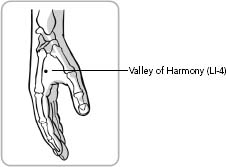
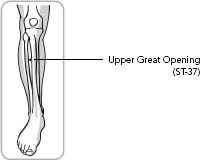

• Find the acupoint Upper Great Opening (ST-37) by measuring 2 hand-widths or 8 finger-widths below the outer indentation of your right knee next to your shinbone. Apply steady pressure with your left thumb until you feel soreness. Hold for 2 minutes. Repeat on the left leg.
AVOID
• Alcohol and coffee, as they tend to deplete fluids in the bowels and cause inflammation, worsening the condition.

• Foods that irritate the intestinal tract, including MSG, preservatives, and additives.

• Smoking, which can worsen hemorrhoids.
HIGH BLOOD PRESSURE
HIGH BLOOD PRESSURE, OR HYPERTENSION, is a condition in which blood pressure is chronically elevated. According to the National Institutes of Health, blood pressure readings of 140/90 mmHg and higher on recurring measurements is considered hypertension. Persistent hypertension is one of the highest risk factors for stroke, heart attack, heart failure, and arterial aneurysm. It is a leading cause of chronic kidney failure. Essential or primary hypertension has no specific causes; it’s associated with genetics, environment, diet, and lifestyle factors, including salt intake, stress, and lack of exercise. Secondary hypertension is a result of other underlying—often serious—conditions such as tumors and kidney or liver disorders. Some medications, such as oral contraceptives, can also cause elevated blood pressure.
According to Chinese medicine, diet and emotions play key roles in hypertension. The Western-style diet is perhaps the primary contributing cause of essential hypertension, according to research. People living in rural areas of China, Brazil, and Africa show no signs of essential hypertension, even with advanced age. Hypertension in Chinese medicine is related to imbalances of the kidney and liver organ systems. If the kidneys fail to regulate the water energy and balance the liver, the liver fire energy rises and causes hypertension. My treatments focus on strengthening the kidney system and regulating the liver by soothing and cooling its fire energy. I’ve also found that teaching my patients meditation practices has enabled the majority of them to control their blood pressure and keep it in check.
I have a number of patients who suffer from “white coat” syndrome—their blood pressure shoots up when they visit the doctor’s office but drops outside of these encounters. I use acupuncture and herbal and dietary therapies to support healthy blood pressure. I also believe in empowering my patients with simple practices such as stress-release meditation, which they can use to gain control over their blood pressure during stressful times—like having their blood pressure measured at their doctors’ offices. One of my patients was able to bring down her blood pressure from 150/98 mmHg to 124/82 mmHg over a three-month period while also overcoming an anxiety condition.
Here are some of my favorite remedies for maintaining good cardiovascular health and clean arteries. Do not stop your blood pressure medication on your own—always consult with your physician before making any changes to your treatment plan.
DIET
• Eat wholesome foods, with no preservatives, additives, or pesticides. Eat smaller meals more frequently. Consume more leafy green vegetables, whole grains, celery, tofu, spinach, garlic, bananas, sunflower seeds, honey, mung beans, bamboo shoots, seaweed, vinegar, tomatoes, water chestnuts, corn, apples, persimmons, peas, buckwheat, jellyfish (soak and cook), watermelon, hawthorn berries (make tea), eggplant, plums, mushrooms, lemons, lotus root, chrysanthemum flowers and cassia seeds (make tea), pearl barley, peach kernels (eaten raw like nuts), ginger, sprouted vegetables, wheat bran, and green tea. Spices including fennel, oregano, black pepper, basil, and tarragon contain active ingredients beneficial for treating hyper-tension. Drink at least six 8-ounce glasses of room temperature water a day.

• Avoid excessive salt, fried and greasy foods, spicy stimulating foods, and simple carbohydrates like sugar and white flour. MSG and other preservatives should also be avoided. Alcohol, coffee, and tobacco should be avoided. Cheeses and aged, cured meats should also be avoided, as they promote plaque buildup.
HOME REMEDIES
• Drink an 8-ounce glass of fresh celery juice 3 times a day for 1 to 3 months, until blood pressure is normal. This is one of the most common Chinese folk remedies for lowering blood pressure, and it works despite the sodium content of the celery.

• First thing upon waking, on an empty stomach, drink 8 ounces of warm water mixed with 1 tablespoon apple cider vinegar and 1 teaspoon honey. Drink this regularly. The honey ensures regularity of the bowels, and is helpful because constipation may aggravate high blood pressure. The vinegar alkalizes the body and lowers blood pressure as well.

• Eat 2 fresh cucumbers every day for 2 weeks, or until blood pressure improves. Since cucumber is a natural diuretic, it will help hydrate your body and lower blood pressure.

• Make a tea by boiling 1/4 cup fresh mint leaves, 1/4 cup dried chrysanthemum flowers, and 2 tablespoons cassia seeds in 5 cups of water for 20 minutes. Strain. Drink 3 cups a day.

• Sleep on a pillow stuffed with mung beans, lentils, and split peas—they help to draw the fire from the head and lower blood pressure.
DAILY SUPPLEMENTS
• Magnesium (600 milligrams), calcium (1,000 milligrams), Zinc (25 milligrams) and essential fatty acids such as gamma-linoleic acid and omega-3 fatty acids (1,000 milligrams EPA) are essential. Magnesium is a vasodilator and helps regulate calcium levels.

• Vitamin B complex helps lower blood pressure. B6 (200 milligrams) acts as a diuretic, while niacin (50 milligrams) relaxes the blood vessels.

• Taking coenzyme Q10 (15 milligrams) 3 times a day can reduce blood pressure.

• Beta carotene (500 milligrams) taken every other day can reduce incidence of coronary and vascular events.

• Folic acid (200 micrograms) taken daily can improve blood flow to the capillaries.
HERBAL THERAPY
• Herbs can be found in health food or vitamin stores, online, and at the offices of Chinese medicine practitioners. Herbs should be used according to individual needs; consult with a licensed practitioner for a customized formulation. To learn more about the herbs listed here, go to www.askdrmao.com.

• Hawthorn berries (150 milligrams) have traditionally been used to support healthy blood pressure levels.

• A traditional Chinese herbal formula called gastrodia gambir is used to support healthy blood pressure. It contains gastrodia, gambir vine, abalone shell, gardenia, skullcap, motherwort, cyathulae, eucommia, loranthus, polygoni, and poria.
EXERCISE
Physical exercise is essential for promoting circulation and strengthening heart function. Sedentary life inhibits circulation. Doing moderate cardiovascular exercise every day for at least 30 minutes will help reduce hyper-tension. Effective moderate exercise includes walking briskly (3 to 4 miles per hour), general calisthenics, racket sports such as table tennis, swimming (with moderate effort), cycling (at a moderate speed of 10 miles per hour or less), canoeing, and rowing (at a speed of about 2 to 4 miles per hour). I’ve also taught many of my patients the following simple stress-release meditation to help control their stress and blood pressure.
Sit comfortably or lie down on your back. Slow your respiration to deep, abdominal breathing. Say the word “calm” in your mind with every exhalation. You’ll be visualizing the relaxation of a specific body part and releasing tension with every exhalation. Trace the following 3 pathways outlined below.
Start at the top of your head. Inhale, and then exhale and visualize your scalp muscles relaxing. Say “calm” in your mind. Repeat, saying the word as you move into each body part, down through your face, throat, chest, abdomen, thighs, knees, calves, ankles, and feet. After you’ve relaxed your feet, visualize all the tension leaving your body through your toes in the form of dark smoke.
Start at the temple region of your head. This path focuses on the sides and upper extremities. Inhale, and then exhale and visualize your temple muscles relaxing. Say “calm” in your mind. Repeat, saying the word as you move into each body part, down through your jaws, the sides of your neck, shoulders, upper arms, elbows, forearms, wrists, and hands. Once you’ve relaxed your hands, visualize all the tension leaving your body through your fingertips in the form of dark smoke.
The final pathway begins at the back of your head. This path relaxes the back of your body. Repeat the breathing-visualization-word routine, as above, as you go from the back of your neck to your upper back, middle back, lower back, back of the thighs, calves, and heels. Then focus on the acupoint Bubbling Spring (KID-1; see illustration below) on the soles of your feet, for 1 minute.
Practice this sequence for at least 15 minutes twice a day.
ACUPRESSURE
• Locate the acupoint Winding Gulch (LI-11), in the depression at the outer part of the right elbow crease, between the elbow tendon and the bone. The point is best located when the arm is bent at 90 degrees with the palm facing the abdomen. Apply steady pressure with your thumb until you feel soreness. Hold for 5 minutes. Repeat on the left arm.

• Find the acupoint Bubbling Spring (KID-1), on the sole of the right foot between the bones of the second and third toes, two-thirds of the distance from the heel to the base of the second toe, just below the ball of the foot in a natural indentation. Apply heavy pressure with your thumb for 5 minutes. Repeat on the left foot.

